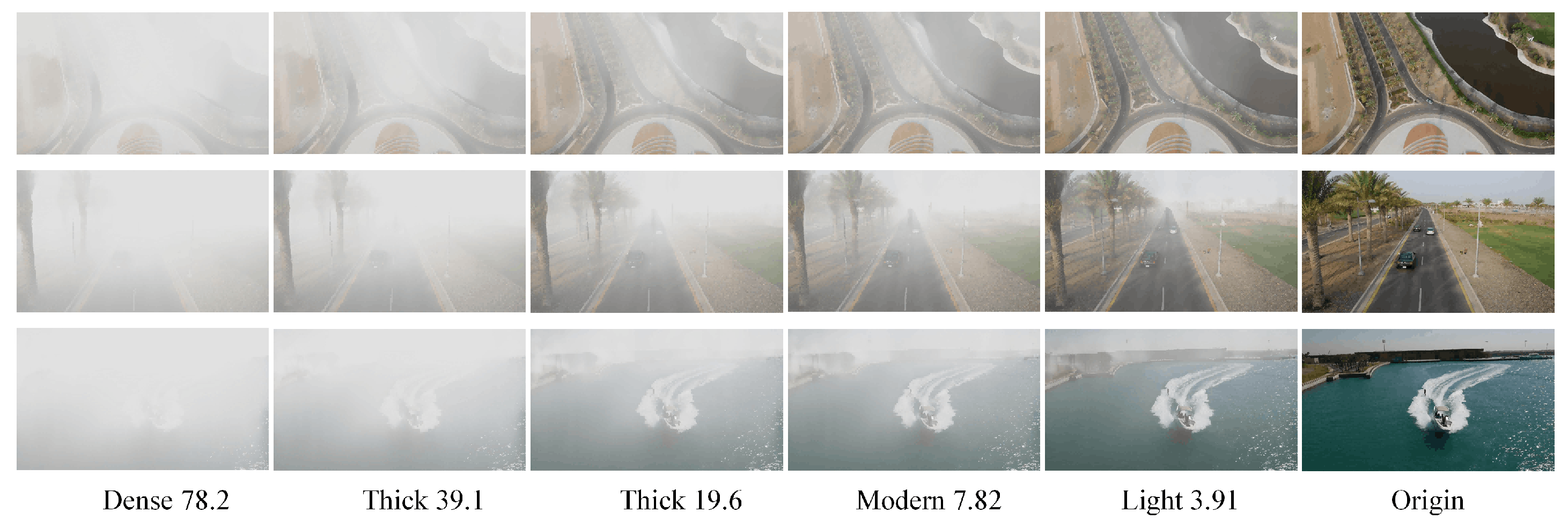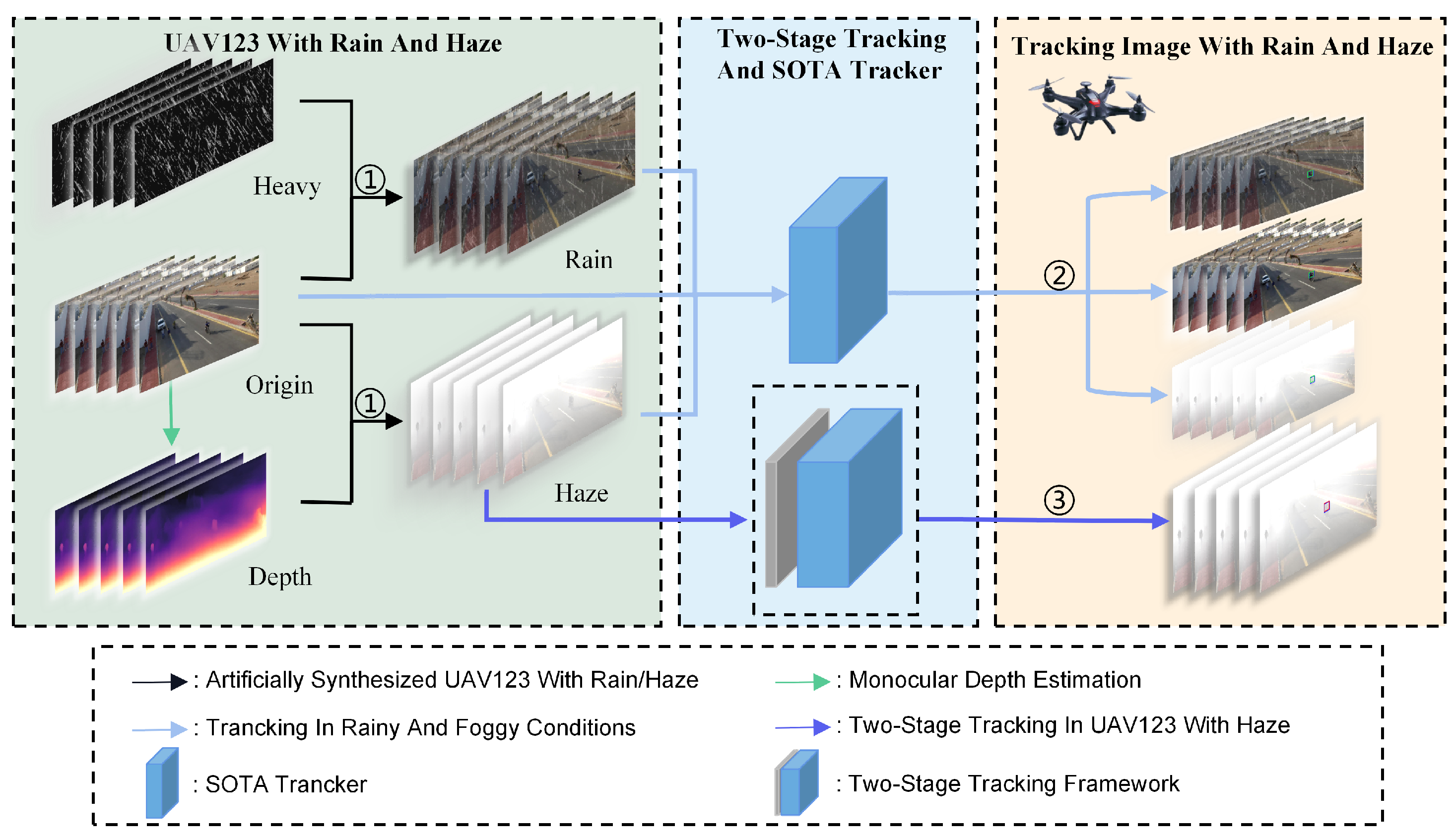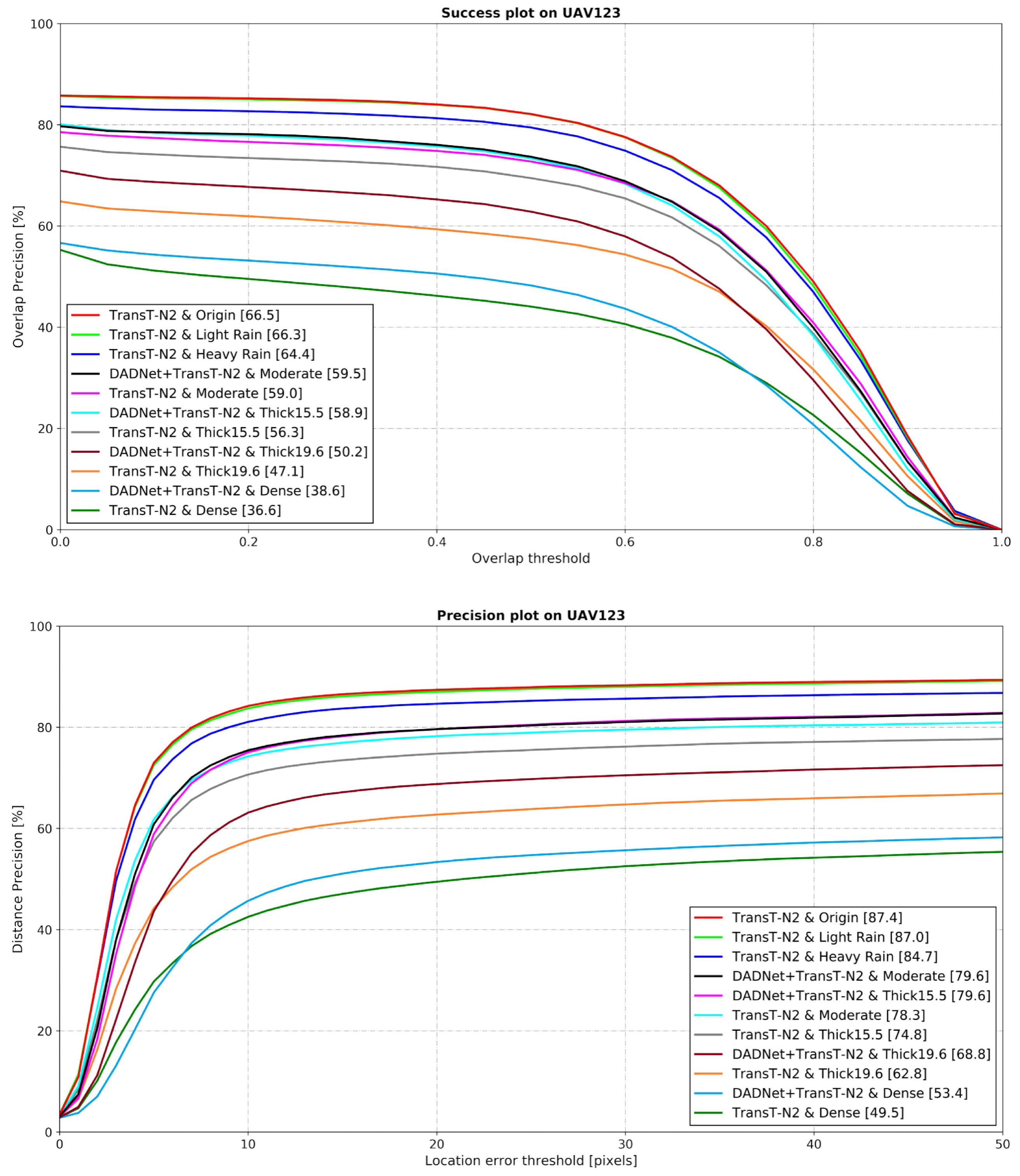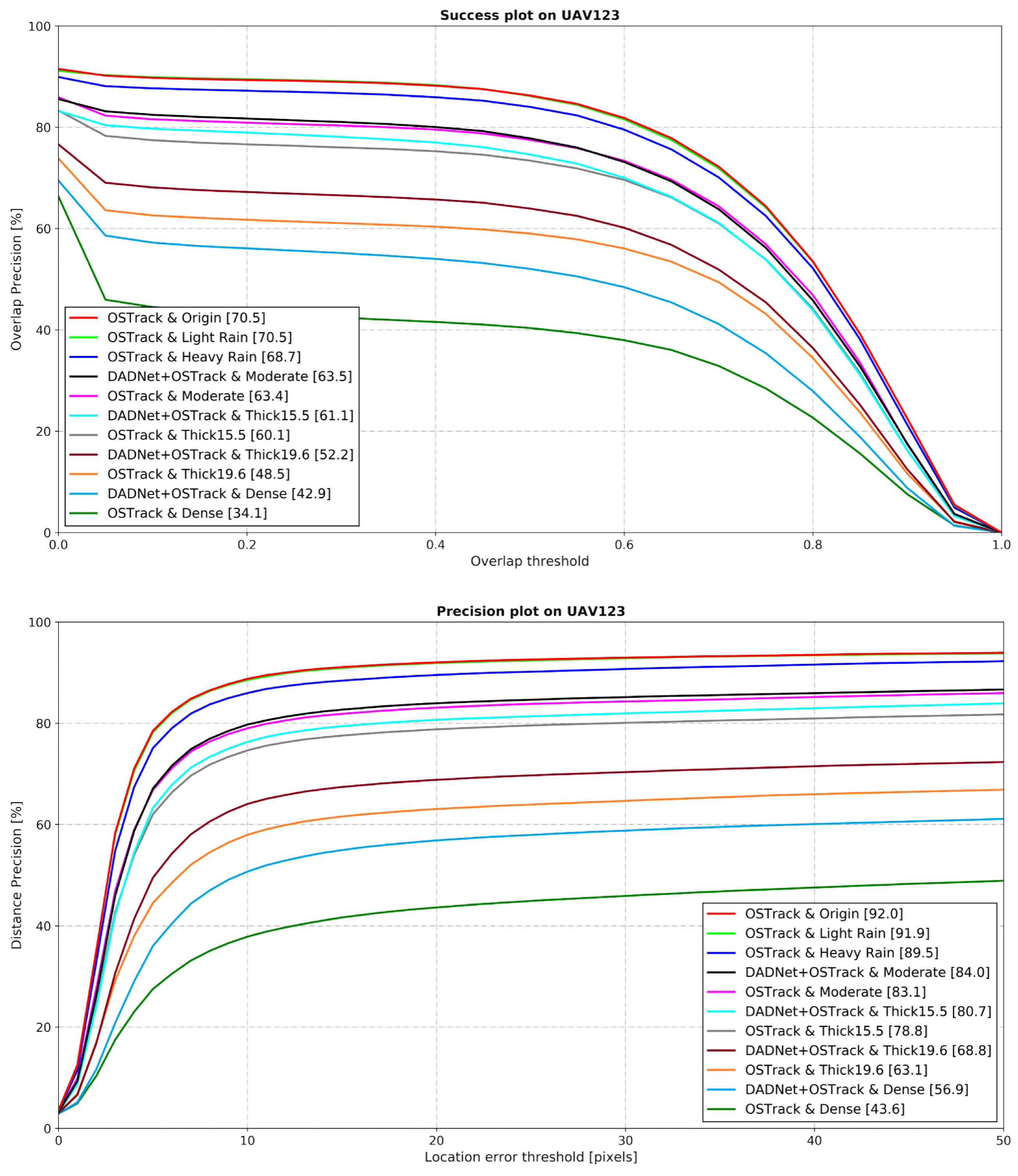A Two-Stage Method for Aerial Tracking in Adverse Weather Conditions
Abstract
:1. Introduction
- We propose a light end-to-end dehazing network called DADNet, which has a good removal effect on high-concentration and unevenly distributed fog. DADNet is fine-tuned to improve the object tracking that follows. Unlike standard image dehazing that aims for overall visual improvement, our method focuses specifically on tracking performance. We use Dilated Attention Blocks (DABs) to protect and highlight the image features that are important for reliable tracking. This focus ensures that our dehazing is a key part of the tracking algorithm, creating a beneficial relationship between the two stages. DADNet also performs better than other dehazing networks in the RESIDE [33] benchmark tests, proving its effectiveness in real-world scenarios.
- A novel two-stage tracking method is proposed to track targets under adverse weather conditions. It combines the light dehazing backbone DADNet with a SOTA tracker. We applied this method to UAV123 [19] with five different levels of fog density. The experimental results show that our two-stage tracking method can effectively solve the problem of tracking errors in adverse weather conditions.
- In order to further analyze the impact of rainy and foggy weather on tracking performance, we conducted experiments using several state-of-the-art trackers, and the experimental results showed that the performance of tracking was greatly affected by foggy weather.
2. Related Work
2.1. Rain Image Formation
2.2. Monocular Depth Estimation Method
2.3. Atmospheric Scattering Model
2.4. Visual Aerial Tracking
3. Method
3.1. Tracking Pipeline
3.2. Overall Architecture of Our Model
3.3. Feature Attention
3.4. Dilated Attention Block
3.5. Multi-Scale Attention Block
3.6. Training Loss
4. Experiments
4.1. Implementation Details
4.2. Evaluation Metrics
4.2.1. Success Rate
4.2.2. Precision
4.3. Evaluation on RESIDE
4.4. Synthesis of the Datasets
4.5. The Impact of Rain on Tracking Performance
4.6. The Impact of Haze on Tracking Performance
4.7. The Comparison of Rain and Fog
4.8. The effDilated Attention Block
4.9. Ablation Study and Analysis
5. Conclusions and Future Research
Author Contributions
Funding
Data Availability Statement
Conflicts of Interest
References
- He, A.; Luo, C.; Tian, X.; Zeng, W. A twofold siamese network for real-time object tracking. In Proceedings of the IEEE Conference on Computer Vision and Pattern Recognition, Salt Lake City, UT, USA, 18–23 June 2018; pp. 4834–4843. [Google Scholar]
- Li, B.; Yan, J.; Wu, W.; Zhu, Z.; Hu, X. High performance visual tracking with siamese region proposal network. In Proceedings of the IEEE Conference on Computer Vision and Pattern Recognition, Salt Lake City, UT, USA, 18–23 June 2018; pp. 8971–8980. [Google Scholar]
- Xu, Y.; Wang, Z.; Li, Z.; Yuan, Y.; Yu, G. Siamfc++: Towards robust and accurate visual tracking with target estimation guidelines. In Proceedings of the AAAI Conference on Artificial Intelligence, New York, NY, USA, 7–12 February 2020; Volume 34, pp. 12549–12556. [Google Scholar]
- Chen, X.; Yan, B.; Zhu, J.; Wang, D.; Yang, X.; Lu, H. Transformer tracking. In Proceedings of the IEEE/CVF Conference on Computer Vision and Pattern Recognition, Nashville, TN, USA, 20–25 June 2021; pp. 8126–8135. [Google Scholar]
- Lin, L.; Fan, H.; Zhang, Z.; Xu, Y.; Ling, H. Swintrack: A simple and strong baseline for transformer tracking. Adv. Neural Inf. Process. Syst. 2022, 35, 16743–16754. [Google Scholar]
- Ye, B.; Chang, H.; Ma, B.; Shan, S.; Chen, X. Joint feature learning and relation modeling for tracking: A one-stream framework. In Proceedings of the European Conference on Computer Vision, Tel Aviv, Israel, 23–27 October 2022; Springer: Berlin/Heidelberg, Germany, 2022; pp. 341–357. [Google Scholar]
- Cui, Y.; Jiang, C.; Wang, L.; Wu, G. Mixformer: End-to-end tracking with iterative mixed attention. In Proceedings of the IEEE/CVF Conference on Computer Vision and Pattern Recognition, New Orleans, LA, USA, 18–24 June 2022; pp. 13608–13618. [Google Scholar]
- Sun, Z.; Liu, C.; Qu, H.; Xie, G. A novel effective vehicle detection method based on swin transformer in hazy scenes. Mathematics 2022, 10, 2199. [Google Scholar] [CrossRef]
- Li, D.; Chai, H.; Wei, Q.; Zhang, Y.; Xiao, Y. PACR: Pixel Attention in Classification and Regression for Visual Object Tracking. Mathematics 2023, 11, 1406. [Google Scholar] [CrossRef]
- Cao, Z.; Huang, Z.; Pan, L.; Zhang, S.; Liu, Z.; Fu, C. TCTrack: Temporal contexts for aerial tracking. In Proceedings of the IEEE/CVF Conference on Computer Vision and Pattern Recognition, New Orleans, LA, USA, 18–24 June 2022; pp. 14798–14808. [Google Scholar]
- Fu, Z.; Liu, Q.; Fu, Z.; Wang, Y. Stmtrack: Template-free visual tracking with space-time memory networks. In Proceedings of the IEEE/CVF Conference on Computer Vision and Pattern Recognition, Nashville, TN, USA, 20–25 June 2021; pp. 13774–13783. [Google Scholar]
- Yan, B.; Peng, H.; Fu, J.; Wang, D.; Lu, H. Learning spatio-temporal transformer for visual tracking. In Proceedings of the IEEE/CVF International Conference on Computer Vision, Montreal, BC, Canada, 11–17 October 2021; pp. 10448–10457. [Google Scholar]
- Gao, S.; Zhou, C.; Ma, C.; Wang, X.; Yuan, J. Aiatrack: Attention in attention for transformer visual tracking. In Proceedings of the European Conference on Computer Vision, Tel Aviv, Israel, 23–27 October 2022; Springer: Berlin/Heidelberg, Germany, 2022; pp. 146–164. [Google Scholar]
- Wu, Y.; Lim, J.; Yang, M.H. Online object tracking: A benchmark. In Proceedings of the IEEE Conference on Computer Vision and Pattern Recognition, Portland, OR, USA, 23–28 June 2013; pp. 2411–2418. [Google Scholar]
- Kristan, M.; Matas, J.; Leonardis, A.; Felsberg, M.; Cehovin, L.; Fernandez, G.; Vojir, T.; Hager, G.; Nebehay, G.; Pflugfelder, R. The visual object tracking vot2015 challenge results. In Proceedings of the IEEE International Conference on Computer Vision Workshops, Washington, DC, USA, 7–13 December 2015; pp. 1–23. [Google Scholar]
- Huang, L.; Zhao, X.; Huang, K. GOT-10k: A Large High-Diversity Benchmark for Generic Object Tracking in the Wild. IEEE Trans. Pattern Anal. Mach. Intell. 2019, 1562–1577. [Google Scholar] [CrossRef]
- Muller, M.; Bibi, A.; Giancola, S.; Alsubaihi, S.; Ghanem, B. Trackingnet: A large-scale dataset and benchmark for object tracking in the wild. In Proceedings of the European Conference on Computer Vision (ECCV), Munich, Germany, 8–14 September 2018; pp. 300–317. [Google Scholar]
- Fan, H.; Lin, L.; Yang, F.; Chu, P.; Deng, G.; Yu, S.; Bai, H.; Xu, Y.; Liao, C.; Ling, H. Lasot: A high-quality benchmark for large-scale single object tracking. In Proceedings of the IEEE/CVF Conference on Computer Vision and Pattern Recognition, Long Beach, CA, USA, 15–20 June 2019; pp. 5374–5383. [Google Scholar]
- Mueller, M.; Smith, N.; Ghanem, B. A benchmark and simulator for uav tracking. In Proceedings of the Computer Vision–ECCV 2016: 14th European Conference, Amsterdam, The Netherlands, 11–14 October 2016; Proceedings, Part I 14; Springer: Berlin/Heidelberg, Germany, 2016; pp. 445–461. [Google Scholar]
- Song, H.; Wang, R. Underwater image enhancement based on multi-scale fusion and global stretching of dual-model. Mathematics 2021, 9, 595. [Google Scholar] [CrossRef]
- Hu, M.; Li, Y.; Fan, J.; Jing, B. Joint Semantic Deep Learning Algorithm for Object Detection under Foggy Road Conditions. Mathematics 2022, 10, 4526. [Google Scholar] [CrossRef]
- Benaddy, A.; Labbadi, M.; Boubaker, S.; Alsubaei, F.S.; Bouzi, M. Predefined-Time Fractional-Order Tracking Control for UAVs with Perturbation. Mathematics 2023, 11, 4886. [Google Scholar] [CrossRef]
- Ancuti, C.; Ancuti, C.O.; De Vleeschouwer, C.; Bovik, A.C. Night-time dehazing by fusion. In Proceedings of the 2016 IEEE International Conference on Image Processing (ICIP), Phoenix, AZ, USA, 25–28 September 2016; pp. 2256–2260. [Google Scholar]
- Ancuti, C.O.; Ancuti, C.; Hermans, C.; Bekaert, P. A fast semi-inverse approach to detect and remove the haze from a single image. In Proceedings of the Asian Conference on Computer Vision, Queenstown, New Zealand, 8–12 November 2010; Springer: Berlin/Heidelberg, Germany, 2010; pp. 501–514. [Google Scholar]
- He, K.; Sun, J.; Tang, X. Single image haze removal using dark channel prior. IEEE Trans. Pattern Anal. Mach. Intell. 2010, 33, 2341–2353. [Google Scholar] [PubMed]
- Meng, G.; Wang, Y.; Duan, J.; Xiang, S.; Pan, C. Efficient image dehazing with boundary constraint and contextual regularization. In Proceedings of the IEEE International Conference on Computer Vision, Sydney, Australia, 1–8 December 2013; pp. 617–624. [Google Scholar]
- Cai, B.; Xu, X.; Jia, K.; Qing, C.; Tao, D. Dehazenet: An end-to-end system for single image haze removal. IEEE Trans. Image Process. 2016, 25, 5187–5198. [Google Scholar] [CrossRef]
- Ren, W.; Liu, S.; Zhang, H.; Pan, J.; Cao, X.; Yang, M.H. Single image dehazing via multi-scale convolutional neural networks. In Proceedings of the Computer Vision–ECCV 2016: 14th European Conference, Amsterdam, The Netherlands, 11–14 October 2016; Proceedings, Part II 14; Springer: Berlin/Heidelberg, Germany, 2016; pp. 154–169. [Google Scholar]
- Yang, X.; Xu, Z.; Luo, J. Towards perceptual image dehazing by physics-based disentanglement and adversarial training. In Proceedings of the AAAI Conference on Artificial Intelligence, New Orleans, LA, USA, 2–7 February 2018; Volume 32. [Google Scholar]
- Zhang, H.; Sindagi, V.; Patel, V.M. Joint transmission map estimation and dehazing using deep networks. IEEE Trans. Circuits Syst. Video Technol. 2019, 30, 1975–1986. [Google Scholar] [CrossRef]
- Chen, D.; He, M.; Fan, Q.; Liao, J.; Zhang, L.; Hou, D.; Yuan, L.; Hua, G. Gated context aggregation network for image dehazing and deraining. In Proceedings of the 2019 IEEE Winter Conference on Applications of Computer Vision (WACV), Waikoloa Village, HI, USA, 7–11 January 2019; pp. 1375–1383. [Google Scholar]
- Qin, X.; Wang, Z.; Bai, Y.; Xie, X.; Jia, H. FFA-Net: Feature fusion attention network for single image dehazing. In Proceedings of the AAAI Conference on Artificial Intelligence, New York, NY, USA, 7–12 February 2020; Volume 34, pp. 11908–11915. [Google Scholar]
- Li, B.; Ren, W.; Fu, D.; Tao, D.; Feng, D.; Zeng, W.; Wang, Z. Benchmarking single-image dehazing and beyond. IEEE Trans. Image Process. 2018, 28, 492–505. [Google Scholar] [CrossRef] [PubMed]
- Zhang, Y.; Ding, L.; Sharma, G. Hazerd: An outdoor scene dataset and benchmark for single image dehazing. In Proceedings of the 2017 IEEE International Conference on Image Processing (ICIP), Beijing, China, 17–20 September 2017; pp. 3205–3209. [Google Scholar]
- Han, J.; Li, W.; Fang, P.; Sun, C.; Hong, J.; Armin, M.A.; Petersson, L.; Li, H. Blind image decomposition. In Proceedings of the European Conference on Computer Vision, Tel Aviv, Israel, 23–27 October 2022; Springer: Berlin/Heidelberg, Germany, 2022; pp. 218–237. [Google Scholar]
- Yang, W.; Tan, R.T.; Feng, J.; Liu, J.; Guo, Z.; Yan, S. Deep joint rain detection and removal from a single image. In Proceedings of the IEEE Conference on Computer Vision and Pattern Recognition, Honolulu, HI, USA, 21–26 July 2017; pp. 1357–1366. [Google Scholar]
- Li, Y.; Tan, R.T.; Guo, X.; Lu, J.; Brown, M.S. Rain streak removal using layer priors. In Proceedings of the IEEE Conference on Computer Vision and Pattern Recognition, Las Vegas, NV, USA, 26 June–1 July 2016; pp. 2736–2744. [Google Scholar]
- Liu, H.; Tang, X.; Shen, S. Depth-map completion for large indoor scene reconstruction. Pattern Recognit. 2020, 99, 107112. [Google Scholar] [CrossRef]
- Sakaridis, C.; Dai, D.; Van Gool, L. Semantic foggy scene understanding with synthetic data. Int. J. Comput. Vis. 2018, 126, 973–992. [Google Scholar] [CrossRef]
- Ding, M.; Huo, Y.; Yi, H.; Wang, Z.; Shi, J.; Lu, Z.; Luo, P. Learning depth-guided convolutions for monocular 3d object detection. In Proceedings of the IEEE/CVF Conference on Computer Vision and Pattern Recognition Workshops, Seattle, WA, USA, 13–19 June 2020; pp. 1000–1001. [Google Scholar]
- Liang, Z.; Feng, Y.; Guo, Y.; Liu, H.; Chen, W.; Qiao, L.; Zhou, L.; Zhang, J. Learning for disparity estimation through feature constancy. In Proceedings of the IEEE Conference on Computer Vision and Pattern Recognition, Salt Lake City, UT, USA, 18–23 June 2018; pp. 2811–2820. [Google Scholar]
- Zhang, J.; Skinner, K.A.; Vasudevan, R.; Johnson-Roberson, M. Dispsegnet: Leveraging semantics for end-to-end learning of disparity estimation from stereo imagery. IEEE Robot. Autom. Lett. 2019, 4, 1162–1169. [Google Scholar] [CrossRef]
- Eigen, D.; Puhrsch, C.; Fergus, R. Depth map prediction from a single image using a multi-scale deep network. Adv. Neural Inf. Process. Syst. 2014, 27. [Google Scholar]
- Fu, H.; Gong, M.; Wang, C.; Batmanghelich, K.; Tao, D. Deep ordinal regression network for monocular depth estimation. In Proceedings of the IEEE Conference on Computer Vision and Pattern Recognition, Salt Lake City, UT, USA, 18–23 June 2018; pp. 2002–2011. [Google Scholar]
- Laina, I.; Rupprecht, C.; Belagiannis, V.; Tombari, F.; Navab, N. Deeper depth prediction with fully convolutional residual networks. In Proceedings of the 2016 Fourth International Conference on 3D Vision (3DV), Stanford, CA, USA, 25–28 October 2016; pp. 239–248. [Google Scholar]
- Godard, C.; Mac Aodha, O.; Firman, M.; Brostow, G.J. Digging into self-supervised monocular depth estimation. In Proceedings of the IEEE/CVF International Conference on Computer Vision, Seoul, Republic of Korea, 27 October–2 November 2019; pp. 3828–3838. [Google Scholar]
- Geiger, A.; Lenz, P.; Stiller, C.; Urtasun, R. Vision meets robotics: The kitti dataset. Int. J. Robot. Res. 2013, 32, 1231–1237. [Google Scholar] [CrossRef]
- McCartney, E.J. Optics of the atmosphere: Scattering by molecules and particles. IEEE J. Quantum Electron. 1976, 14, 698–699. [Google Scholar] [CrossRef]
- Fan, Q.; Chen, D.; Yuan, L.; Hua, G.; Yu, N.; Chen, B. Decouple learning for parameterized image operators. In Proceedings of the European Conference on Computer Vision (ECCV), Munich, Germany, 8–14 September 2018; pp. 442–458. [Google Scholar]
- Fan, Q.; Yang, J.; Hua, G.; Chen, B.; Wipf, D. A generic deep architecture for single image reflection removal and image smoothing. In Proceedings of the IEEE International Conference on Computer Vision, Venice, Italy, 22–29 October 2017; pp. 3238–3247. [Google Scholar]
- Liu, Z.; Xiao, B.; Alrabeiah, M.; Wang, K.; Chen, J. Generic model-agnostic convolutional neural network for single image dehazing. arXiv 2018, arXiv:1810.02862. [Google Scholar] [CrossRef]
- He, K.; Zhang, X.; Ren, S.; Sun, J. Deep residual learning for image recognition. In Proceedings of the IEEE Conference on Computer Vision and Pattern Recognition, Las Vegas, NV, USA, 26 June–1 July 2016; pp. 770–778. [Google Scholar]
- Szegedy, C.; Liu, W.; Jia, Y.; Sermanet, P.; Reed, S.; Anguelov, D.; Erhan, D.; Vanhoucke, V.; Rabinovich, A. Going deeper with convolutions. In Proceedings of the IEEE Conference on Computer Vision and Pattern Recognition, Boston, MA, USA, 7–12 June 2015; pp. 1–9. [Google Scholar]
- Yu, F.; Koltun, V. Multi-scale context aggregation by dilated convolutions. arXiv 2015, arXiv:1511.07122. [Google Scholar]
- Wang, Z.; Ji, S. Smoothed dilated convolutions for improved dense prediction. In Proceedings of the 24th ACM SIGKDD International Conference on Knowledge Discovery & Data Mining, New York, NY, USA, 19–23 August 2018; pp. 2486–2495. [Google Scholar]
- Hamaguchi, R.; Fujita, A.; Nemoto, K.; Imaizumi, T.; Hikosaka, S. Effective use of dilated convolutions for segmenting small object instances in remote sensing imagery. In Proceedings of the 2018 IEEE Winter Conference on Applications of Computer Vision (WACV), Lake Tahoe, NV, USA, 12–15 March 2018; pp. 1442–1450. [Google Scholar]
- Li, B.; Peng, X.; Wang, Z.; Xu, J.; Feng, D. Aod-net: All-in-one dehazing network. In Proceedings of the IEEE International Conference on Computer Vision, Venice, Italy, 22–29 October 2017; pp. 4770–4778. [Google Scholar]
- Lim, B.; Son, S.; Kim, H.; Nah, S.; Mu Lee, K. Enhanced deep residual networks for single image super-resolution. In Proceedings of the IEEE Conference on Computer Vision and Pattern Recognition Workshops, Honolulu, HI, USA, 21–26 July 2017; pp. 136–144. [Google Scholar]
- Zhu, Q.; Mai, J.; Shao, L. A fast single image haze removal algorithm using color attenuation prior. IEEE Trans. Image Process. 2015, 24, 3522–3533. [Google Scholar]
- Li, B.; Peng, X.; Wang, Z.; Xu, J.; Feng, D. An all-in-one network for dehazing and beyond. arXiv 2017, arXiv:1707.06543. [Google Scholar]
- Ren, W.; Ma, L.; Zhang, J.; Pan, J.; Cao, X.; Liu, W.; Yang, M.H. Gated fusion network for single image dehazing. In Proceedings of the IEEE Conference on Computer Vision and Pattern Recognition, Salt Lake City, UT, USA, 18–22 June 2018; pp. 3253–3261. [Google Scholar]
- Chen, C.; Do, M.N.; Wang, J. Robust image and video dehazing with visual artifact suppression via gradient residual minimization. In Proceedings of the Computer Vision–ECCV 2016: 14th European Conference, Amsterdam, The Netherlands, 11–14 October 2016; Proceedings, Part II 14; Springer: Berlin/Heidelberg, Germany, 2016; pp. 576–591. [Google Scholar]









| 170 m | 200 m | 300 m | 350 m | 500 m | |
|---|---|---|---|---|---|
| weather condition | Dense | Thick | Thick | Moderate | Light |
| scattering coef. | 26.1 | 19.6 | 15.5 | 13.7 | 7.8 |
| GRM [62] | CAP [59] | AOD-Net [60] | DeHaze-Net [27] | GFN [61] | GCANet [31] | Ours | |
|---|---|---|---|---|---|---|---|
| PSNR | 18.86 | 19.05 | 19.06 | 21.14 | 22.30 | 30.23 | 31.71 |
| SSIM | 0.8600 | 0.8400 | 0.8504 | 0.8472 | 0.8800 | 0.9800 | 0.9845 |
| Tracker | Original Image | Light Rain | Heavy Rain | |||||||||
|---|---|---|---|---|---|---|---|---|---|---|---|---|
| AUC | OP50 | OP75 | Prec. | AUC | OP50 | OP75 | Prec. | AUC | OP50 | OP75 | Prec. | |
| OSTrack | 70.52 | 86.28 | 64.45 | 92.04 | 70.47 | 86.18 | 64.17 | 91.90 | 68.89 | 84.03 | 62.51 | 89.54 |
| TransT | 66.53 | 82.13 | 59.99 | 87.43 | 66.29 | 82.08 | 59.31 | 87.03 | 64.38 | 79.47 | 57.73 | 84.66 |
| Weather | OSTrack | DADNet+OSTrack | TransT | DADNet+TransT | ||||||||
|---|---|---|---|---|---|---|---|---|---|---|---|---|
| AUC | Precision | FPS | AUC | Precision | FPS | AUC | Precision | FPS | AUC | Precision | FPS | |
| Origin | 70.52 | 92.04 | 41.4 | 70.41 | 91.82 | 39.3 | 66.53 | 87.43 | 69.1 | 66.46 | 86.89 | 60.7 |
| Light Fog | 67.30 | 88.27 | 41.4 | 67.37 | 91.47 | 39.3 | 63.53 | 84.11 | 69.1 | 63.59 | 84.87 | 60.7 |
| Moderate Fog | 63.36 | 78.16 | 41.4 | 63.50 | 83.97 | 39.3 | 58.96 | 78.26 | 69.1 | 59.47 | 79.64 | 60.7 |
| Thick Fog (15.5) | 60.10 | 74.18 | 41.4 | 61.06 | 80.69 | 39.3 | 56.31 | 74.78 | 69.1 | 58.91 | 79.62 | 60.7 |
| Thick Fog (19.6) | 48.50 | 63.08 | 41.4 | 52.20 | 68.84 | 39.3 | 47.05 | 62.75 | 69.1 | 50.17 | 68.79 | 60.7 |
| Dense Fog | 34.10 | 43.63 | 41.4 | 42.89 | 56.88 | 39.3 | 36.59 | 49.47 | 69.1 | 38.56 | 53.36 | 60.7 |
| Attention in Dilated Conv | ✗ | ✓ | ✓ | ✓ |
| Normalization in CA and PA | ✗ | ✗ | ✓ | ✓ |
| SSIM Loss | ✗ | ✗ | ✗ | ✓ |
| PSNR | 28.63 | 28.92 | 30.31 | 31.71 |
Disclaimer/Publisher’s Note: The statements, opinions and data contained in all publications are solely those of the individual author(s) and contributor(s) and not of MDPI and/or the editor(s). MDPI and/or the editor(s) disclaim responsibility for any injury to people or property resulting from any ideas, methods, instructions or products referred to in the content. |
© 2024 by the authors. Licensee MDPI, Basel, Switzerland. This article is an open access article distributed under the terms and conditions of the Creative Commons Attribution (CC BY) license (https://creativecommons.org/licenses/by/4.0/).
Share and Cite
Feng, Y.; Xu, X.; Chen, N.; Song, Q.; Zhang, L. A Two-Stage Method for Aerial Tracking in Adverse Weather Conditions. Mathematics 2024, 12, 1216. https://doi.org/10.3390/math12081216
Feng Y, Xu X, Chen N, Song Q, Zhang L. A Two-Stage Method for Aerial Tracking in Adverse Weather Conditions. Mathematics. 2024; 12(8):1216. https://doi.org/10.3390/math12081216
Chicago/Turabian StyleFeng, Yuan, Xinnan Xu, Nuoyi Chen, Quanjian Song, and Lufang Zhang. 2024. "A Two-Stage Method for Aerial Tracking in Adverse Weather Conditions" Mathematics 12, no. 8: 1216. https://doi.org/10.3390/math12081216
APA StyleFeng, Y., Xu, X., Chen, N., Song, Q., & Zhang, L. (2024). A Two-Stage Method for Aerial Tracking in Adverse Weather Conditions. Mathematics, 12(8), 1216. https://doi.org/10.3390/math12081216






